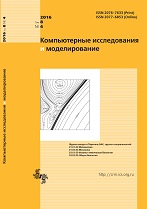|
This article is cited in 2 scientific papers (total in 2 papers)
MODELS IN PHYSICS AND TECHNOLOGY
Quantitative assessment of seismic risk and energy concepts of earthquake engineering
G. A. Dzhinchvelashvilia, R. I. Dzerzhinskyb, N. N. Denisenkovac
a Russian Open Transport Academy of Moscow State University of Railway Transport,
Obrazcova st. 9/9, Moscow, 127994, Russia
b Moscow Technological University (MIREA),
Prospect Vernadsky 78, Moscow, Central Federal District, 119454, Russia
c Russian Economic University named after G. V. Plekhanova,
Stremyanniy Lane 36, Moscow, 117997, Russia
Abstract:
Currently, earthquake-resistant design of buildings based on the power calculation and presentation of effect of the earthquake static equivalent forces, which are calculated using elastic response spectra (linear-spectral method) that connects the law of motion of the soil with the absolute acceleration of the model in a nonlinear oscillator.
This approach does not directly take into account either the influence of the duration of strong motion or the plastic behavior of the structure. Frequency content and duration of ground vibrations directly affect the energy received by the building and causing damage to its elements. Unlike power or kinematic calculation of the seismic effect on the structure can be interpreted without considering separately the forces and displacements and to provide, as the product of both variables, i.e., the work or input energy (maximum energy that can be purchased building to the earth-quake).
With the energy approach of seismic design, it is necessary to evaluate the input seismic energy in the structure and its distribution among various structural components.
The article provides substantiation of the energy approach in the design of earthquake-resistant buildings and structures instead of the currently used method based on the power calculation and presentation of effect of the earth-quake static equivalent forces, which are calculated using spectra of the reaction.
Noted that interest in the use of energy concepts in earthquake-resistant design began with the works of Housner, which provided the seismic force in the form of the input seismic energy, using the range of speeds, and suggested that the damage in elastic-plastic system and elastic system causes one and the same input seismic energy.
The indices of the determination of the input energy of the earthquake, proposed by various authors, are given in this paper. It is shown that modern approaches to ensuring seismic stability of structures, based on the representation of the earthquake effect as a static equivalent force, do not adequately describe the behavior of the system during an earthquake.
In this paper, based on quantitative estimates of seismic risk analyzes developed in the NRU MSUCE Standard Organization (STO) “Seismic resistance structures. The main design provisions”. In the developed document a step forward with respect to the optimal design of earthquake-resistant structures.
The proposed concept of using the achievements of modern methods of calculation of buildings and structures on seismic effects, which are harmonized with the Eurocodes and are not contrary to the system of national regulations.
Keywords:
the earthquake resistance of buildings, the energy method, earthquake-resistant construction, spectra response, the input earthquake energy, earthquake recurrence period, seismic risk, anti-seismic measures, conceptual design, two-tiered calculation, seismic resistance criteria, nonlinear static and nonlinear dynamic calculation method.
Received: 18.06.2017
Revised: 07.12.2017
Accepted: 11.12.2017
Citation:
G. A. Dzhinchvelashvili, R. I. Dzerzhinsky, N. N. Denisenkova, “Quantitative assessment of seismic risk and energy concepts of earthquake engineering”, Computer Research and Modeling, 10:1 (2018), 61–76
Linking options:
https://www.mathnet.ru/eng/crm119 https://www.mathnet.ru/eng/crm/v10/i1/p61
|

| Statistics & downloads: |
| Abstract page: | 377 | | Full-text PDF : | 282 | | References: | 38 |
|




 Contact us:
Contact us: Terms of Use
Terms of Use
 Registration to the website
Registration to the website Logotypes
Logotypes








 Citation in format
Citation in format 
